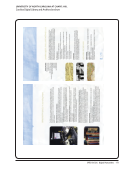SPEC Kit 326: Digital Humanities · 37
The library provides scanning and image editing services so we do not directly support such hardware for direct use by
faculty partners.
These types of hardware are used by staff throughout the library in their support of digital humanities projects it has
not been our policy to provide these services to our patron. It is considered a service provided by the library.
To this point, these are tools our staff works on for the collaborator we do not have dedicated scanners, etc. for outside
collaborators.
Video cameras, audio recorders, audio recording studio, video recording studio, dedicated usability lab.
We are currently researching more hardware, but have not purchased anything, yet.
We plan to offer all of these in a near future.
We provide video conferencing equipment in a large meeting room. Providing visualization tools is a future service we
will offer. We also have substantive wireless networking services and a small wired training lab.
12. What software does the library offer to support digital humanities projects? Check all that apply.
N=46
Bibliographic management software 40 87%
Content Management Systems 36 78%
GIS 29 63%
Data analysis tools 23 50%
TEI 19 41%
Project management software 16 35%
Data visualization software 11 24%
3D rendering platforms 9 20%
Concept/mind mapping software 8 17%
Other software, please describe 16 35%
All of these are available in different forms in the libraries. None are promoted as “digital humanities” specific.
Some of these are often best served by software that is available at no cost for academics (pivotal tracker for project
management, etc.), so the libraries offer them via consultation and not as a paid service.
Collaborate with Scholars Portal to develop data tools, for geographical health informatics and statistical data (under
development).
CONTENTdm for housing collections, managing metadata, handling OCR, etc.
Digital library/institutional repository software (DSpace).
The library provides scanning and image editing services so we do not directly support such hardware for direct use by
faculty partners.
These types of hardware are used by staff throughout the library in their support of digital humanities projects it has
not been our policy to provide these services to our patron. It is considered a service provided by the library.
To this point, these are tools our staff works on for the collaborator we do not have dedicated scanners, etc. for outside
collaborators.
Video cameras, audio recorders, audio recording studio, video recording studio, dedicated usability lab.
We are currently researching more hardware, but have not purchased anything, yet.
We plan to offer all of these in a near future.
We provide video conferencing equipment in a large meeting room. Providing visualization tools is a future service we
will offer. We also have substantive wireless networking services and a small wired training lab.
12. What software does the library offer to support digital humanities projects? Check all that apply.
N=46
Bibliographic management software 40 87%
Content Management Systems 36 78%
GIS 29 63%
Data analysis tools 23 50%
TEI 19 41%
Project management software 16 35%
Data visualization software 11 24%
3D rendering platforms 9 20%
Concept/mind mapping software 8 17%
Other software, please describe 16 35%
All of these are available in different forms in the libraries. None are promoted as “digital humanities” specific.
Some of these are often best served by software that is available at no cost for academics (pivotal tracker for project
management, etc.), so the libraries offer them via consultation and not as a paid service.
Collaborate with Scholars Portal to develop data tools, for geographical health informatics and statistical data (under
development).
CONTENTdm for housing collections, managing metadata, handling OCR, etc.
Digital library/institutional repository software (DSpace).
































































































































































































